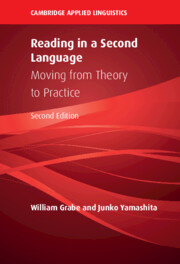Book contents
- Reading in a Second Language
- The Cambridge Applied Linguistics Series
- Reading in a Second Language
- Copyright page
- Dedication
- Contents
- Figures
- Tables
- Preface
- Part I Foundations of Reading
- Part II Patterns of Variation in Reading
- Part III Developing Reading Comprehension Abilities
- Part IV Expanding Reading Comprehension Skills
- 15 Reading to Learn and Reading–Writing Relationships
- 16 Reading in Digital Contexts
- 17 Reading Fluency, Reading Rate, and Comprehension
- 18 Extensive Reading
- Part V Applications of Reading Research: Instruction and Assessment
- References
- Author Index
- Subject Index
17 - Reading Fluency, Reading Rate, and Comprehension
from Part IV - Expanding Reading Comprehension Skills
Published online by Cambridge University Press: 01 September 2022
- Reading in a Second Language
- The Cambridge Applied Linguistics Series
- Reading in a Second Language
- Copyright page
- Dedication
- Contents
- Figures
- Tables
- Preface
- Part I Foundations of Reading
- Part II Patterns of Variation in Reading
- Part III Developing Reading Comprehension Abilities
- Part IV Expanding Reading Comprehension Skills
- 15 Reading to Learn and Reading–Writing Relationships
- 16 Reading in Digital Contexts
- 17 Reading Fluency, Reading Rate, and Comprehension
- 18 Extensive Reading
- Part V Applications of Reading Research: Instruction and Assessment
- References
- Author Index
- Subject Index
Summary
Chapter 17: Reading Fluency, Reading Rate, and Comprehension. This chapter reviews research on the role of reading fluency on reading comprehension in both L1 and L2 contexts. Reading fluency is a complex topic in itself, sometimes seen as a component skill contributing to comprehension and sometimes viewed as a reading goal in itself. Reading fluency is defined according to multiple criteria: automaticity, rate, accuracy, and prosodic phrasing. Research on fluency also involves fluent word reading and fluent text passage reading. As research has demonstrated over decades, word reading fluency contributes to early reading development, but text passage reading is a strong predictor of later reading comprehension. This appears to be true in both L1 and L2 contexts. The chapter reviews the major research findings and concludes with implications for instruction.
- Type
- Chapter
- Information
- Reading in a Second LanguageMoving from Theory to Practice, pp. 403 - 418Publisher: Cambridge University PressPrint publication year: 2022

